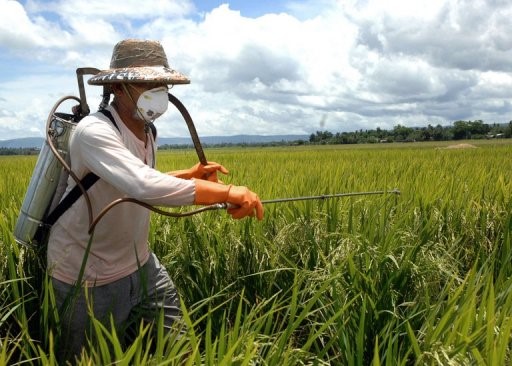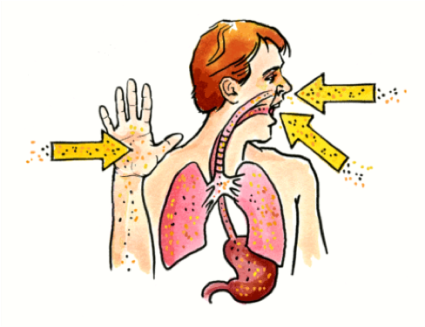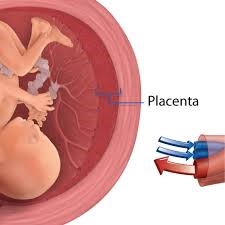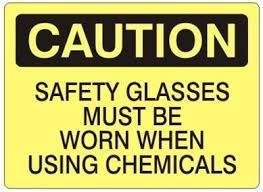
Introduction
Mr. Ali is experiencing itchiness on his hand after a few minutes using pesticide in his garden. Such phenomenon is often heard on media, documentaries and so on.
Mishandling of chemical substances will end up in an accident such as spillage, explosion, and chemically-related diseases as well.
Know Your Chemical
- Route entry There are 5 routes of entry chemical substance into the body :
- Inhalation : This is the most significant route of entry compared to the other. Chemical in all sort of namely droplets, gaseous, vapours, mist penetrates into alveoli. It then carried to the organs through blood circulation system.

Picture 1: Electronic cigarette (Source: http://www.livescience.com) - Skin absorption and membrane layers. A chemical substance in solid, liquid, vapours, aerosol or chemical fumes can be absorbed into the body through skin contact or sometimes be named dermal exposure.

Picture 2: Ways of chemical substances enter the body - Eye absorption: Chemical like toluene can penetrate the outer layer of the eyes and soon transported to body organs (liver, heart, kidney) via the eyes nerve.
- Transplacental absorption :The foetus comes into contact with the chemical substance through the transplacental process.

Picture 3: Chemical substances being transferred to the foetus (Source: http://www.katecampbell.ca/) - Ingestion : This is not the major route of the chemical method of entry. It is associated with poor personal hygiene. Eating with unwashed hand after handling chemical can transfer the chemical through the mouth.
Chemical substances which got inside the body will be in the blood circulation system. From thereon it will be circulated to multi-organs like the liver, kidney, cerebral nervous system, blood, skin, heart, and lung. The role of the lung is to detoxify the chemical into a harmless substance (metabolism). The process of metabolism will produce a more toxic chemical substance.
- The excretion of chemical substance
The chemical substance in the body will be excreted out through urine, faeces, respiration, perspiration and lactation. - Two category of chemical substance.
The chemical is divided into two large group namely organic chemical and non-organic chemical. The organic chemical contains carbon and hydrogen while non-organic chemical does not have carbon compound. - Chemical poisoning prevention
- Elimination
Eliminate the use of products that have a high level of chemical toxicity. Eliminate the process of chemical handling that exposes the worker to the chemical hazard. - Substitution
Substitute the use of high toxicity chemical to low toxicity. This will reduce the magnitude of hazard to the user. - Engineering control
- Use mechanical device while dealing with chemicals.
- The local exhaust ventilation at the chemical point
source. - Install natural or mechanical ventilation to reduce the chemical concentration at the workplace.
- Administration control
- Training of chemical use.
- Dissemination of chemical information to the staff. Example: pamphlet, training, Chemical Safety Data Sheet (CSDS), Safety Operation Procedure (SOP).
- Place appropriate chemical warning signages.

Picture 4: Example of chemical warning signage (Source: http://www.safetysupplywarehouse.com)
- Personal protection equipment (PPE)
Wear appropriate PPE. Eg overall, nitrile glove, eye goggle, safety boot, apron.
|
|
Exposure risk
- Below are the categories of chemical risk exposure:
NO RISK
EXPLANATION
1 Acute High dose of exposure within a short period of time. Immediate effect. Eg. Scan irritation. 2 Chronic Continuous or repeated exposure over months or years with a low dose. 3 Reversible (temporary) An effect that disappears if exposure to the chemical ceases. 4 Irreversible (permanent) An effect that has a lasting, damaging effect on the body, even if exposure to the chemical ceases. 5 Local The chemical causes harm at the point of contact or entry 6 Systemic The chemicals enters the body, is absorbed and transported to the various organs of the body. - Below are the health effect caused by chemical:
HEALTH
EFFECTDETAILS
EXAMPLES
Irititans Chemicals may cause local irritation or inflammation to the eyes/skin/nose or respiratory system tissue. These effects are often reversible Nitorgen oxides, sulphur dioxide, formaldehyde Sensitizer Chemicals may cause or initiate an allergic reaction. How long the effect will occur depending on the individual susceptibility to the chemical Toluene di-isocyanate, nickel at chromium compounds Corrosive Chemicals that may destroy or deteriorates living tissue upon contact Asid sulphuric, sodium hydroxide Hepatotoxins Chemicals that may damage the liver Carbon tetrachloride, chloroform Nepthrotoxins Chemicals that may damage the kidney. Halogenated hydrocarbon, lead, uranium, cadmium Neurotoxins Chemicals that may damage the nervous system Mercury, carbon disulphide Narcotic Chemicals that may depress the central nervous system and it is fatal Acetone, xylene, chloroform, ethyl ether Carcinogen Chemicals that causes cancer Acrylonitrile, asbestos, arsenic, benzene Mutagen Chemical that may causes permanent damage to the DNA in a cell Dioxin, mercury, chloroprene, ionizing radiation Teratogen Chemicals may cause birth defects Plumbum, formamides, methyl mercury Asphyxiation Chemical that may interfere with the ability of living tissue to absorb oxygen Carbon dioxide, nitrogen, helium, carbon monoxide, hydrogen cyanide
References
- Ashafl, C. R., Rieske, D. W. (2010). Industrial Safety & Health Management (6th ed.). Prentice Hall.
- Chemical Hazard and Alternative Toolbox. (n.d.). Benzaldehyde. Diambil dari: http://www.chemhat.org/en/chemical/100-52-7/benzaldehyde (Diakses pada 18/11/2015).
- Chemical Safety. (2001). Malaysian Institute for Nuclear Technology Research (MINT). Bangi, Kajang.
- Chemical Safety. (2012). Open University of Malaysia.
- Ronald Scott (1997).Basic concepts of Industrial Hygiene. Francis and Taylor.
- Sunil S.R., & Jain, R.K. (2015). Industrial Safety, Health and Environment Management Systems. Delhi, IND: Khanna Publishers.
| Semakan akhir | : | 25 Mac 2016 |
| Penulis | : | Padelin Rimpau |
| Akreditor | : | Tn. Hj. Rosnani bin Ab. Hamid |








